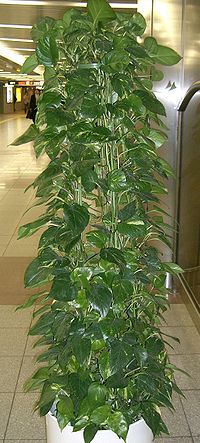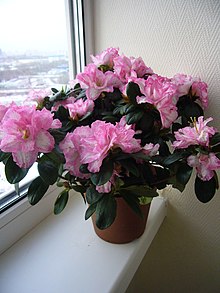Houseplant
An indoor plant is any plant species grown indoors, such as homes or offices. For the most part, they are varieties from tropical climates that acclimatize in foreign geographical environments thanks to the fact that indoor cultivation provides them with the right conditions. They should not be confused with some balcony or garden plants, which are temporarily located indoors but require longer periods outside to survive.
This type of plant is usually grown for decorative purposes or for health reasons, such as air purifiers. They can be grouped recreating jungle environments, in greenhouses and glazed viewpoints; this was very common in the Victorian era.
Cultivation
The main factors that should be considered in this type of plants are soil moisture, light, ambient humidity, temperature, fertilizers, potting and pest control.
Soil moisture
Both excess and insufficient watering can be detrimental to the plant. The best way to determine if a plant needs watering is to check the soil moisture. To do this, the surface of the earth is touched and a finger is inserted lightly into the substrate. The soil can vary from very wet (as if it was just watered) to very dry. Typically, a houseplant needs watering about once a week, although applying this rule rigidly is not recommended. To irrigate, spray water evenly over the surface of the growing medium until it begins to drain out of the bottom of the pot, ensuring complete saturation.
Light
Through the process of photosynthesis, plants convert solar energy into chemical energy, which makes them grow. The two important factors in providing light to a plant are intensity and duration.
Each type of plant requires a different light intensity. Light intensity (or quality) is difficult to measure without a lux meter, which measures in units of lux. 100 lux or less is normally considered "low intensity" or "indirect" light. A bright office has an approximate illumination of 400 lux. 1,000 lux or more is considered "high intensity" lighting. Direct sunlight outdoors is in the order of 32,000 to 100,000 lux.
The duration of the light exposure is just as important as the intensity. The exposure quality of between 8 to 16 hours is ideal for most plants. In the Northern Hemisphere, South-facing windows have the greatest amount of sun exposure, while West, East, and North-facing windows have progressively less exposure. Direct sunlight is ideal, but natural sunlight through a window is unpredictable - seasonal changes, cloud cover and glass treatment can affect the amount of incoming light.
Artificial light sources can provide an alternative or supplement to lighting received from windows. Fluorescent lighting provides excellent light quality, while standard incandescent bulbs provide very little growth stimulation. The "blue" or "cold" they provide the necessary light for plants with green foliage, while the "warm ones" or "reds" They are suitable for flowering plants. There are fluorescent bulbs that fit into standard sockets.
Soil
Indoor plants are usually grown in special soils called potting compost or potting substrate, not natural soil. A good potting mix includes soil conditioners that provide the plant with adequate nutrients, support, drainage, and aeration. Most of these composts contain a combination of peat and vermiculite or perlite. However, concern for the environmental damage caused in the marshes is leading to replace peat with coconut fiber, a sustainable resource.
If you choose to use natural soil from the area, you should, as a first step, sterilize it by heat, putting the substrate in an oven at 90ºC for at least 30 minutes. This will prevent the soil from containing harmful bacteria. Most soils, especially those with a high proportion of clay, do not drain sufficiently to be considered a suitable growing medium for houseplants, so peat or coir is used to increase aeration and make heavy soils more absorbent. Vermiculite and perlite also help drainage, although perlite is more recommended, since it does not crumble so easily. If necessary, coarse sand or gravel can also be used as a substitute to increase drainage. These three ingredients can be mixed in various ratios to create different types of potting mix. For plants that require rapid drainage, such as cacti, use more coarse sand, gravel or perlite. For those that need a greater amount of moisture, more peat or coconut fiber will be used. A good potting mix for all types of plants consists of 2 parts coir and 1 part perlite (or vermiculite). The so-called "heavy substrate mix" contains sterilized soil, crumbled sphagnum moss or coconut fiber, and perlite in equal proportions. It is also possible to make a substrate mixture that does not contain any soil by mixing equal parts peat and perlite (or vermiculite), this combination will retain more moisture.
Temperature
Most indoor plants are tropical species selected for their adaptation to growing in a climate that varies between 15 and 25 °C, similar to what exists in most houses. Temperature control in other plants with different requirements will need to pay more attention to space heating and/or cooling.
Ambient humidity
Humidity is somewhat more difficult to control than temperature. Most plants thrive in 80% relative humidity, while most homes maintain 20-60% relative humidity. Apart from buying a humidifier, there are some home ways that can increase the humidity. One of the most popular is to use small pebbles, frosted crystals or other similar material, a bed of this material is placed in the bottom of the plant's drainage pot and filled with water, the evaporation of this water will produce humidity at its around. Another method is to group the plants instead of placing them isolated in areas with drafts.
Fertilizers
Under potting conditions, soil nutrients become depleted over time, fertilizers supply these nutrients artificially. However, adding fertilizers unnecessarily can be detrimental to the plant, so you have to consider some symptoms such as slow growth, yellowing of the leaves or falling of new leaves to judge if the subscriber is necessary.
Fertilizers are usually marked with numbers, such as 20-20-20. These indicate the percentage of nitrogen, phosphorus and potassium, elements necessary for plant growth. The 20-20-20 combination is generally suitable for green plants, while 10-20-10 is usually better for flowering plants.
The safety of a fertilizer depends on the dissolution that can be made of the product. Although some variation may occur depending on the brand, a general rule of thumb is to dilute one tablespoon per 1 gallon of water. In all cases, it is safer to under-fertilize than to over-fertilize. This solution will be used to irrigate the plants and the growth will be monitored to determine if the desired effect has been achieved and the frequency with which it should be administered. Subscriber needs can vary from biweekly to every three months.
Pot types and sizes
The size of the pots is an important factor to consider. A pot that is too large will cause disease of the roots due to excess moisture retained in the substrate, while a pot that is too small will restrict the growth of the plant. In general, a plant can stay in the same pot for about two years.
There are a wide variety of pots, but they can usually be divided into two groups: porous and non-porous. The porous ones are normally made of clay, a highly recommended material since they provide better aeration, by allowing air to pass through the sides. Non-porous ones, such as ceramic or plastic ones, tend to hold moisture for longer and restrict airflow. Another necessary feature is the drainage holes. Pots usually come with holes in the bottom to allow excess water to drain from the soil and prevent root rot. In the event that a pot does not have these holes, a drainage mechanism can be created by putting clay fragments or pebbles in the bottom before filling it with the substrate, which will cause excess water to settle in this space instead. from remaining in the ground.
Old pots should be washed carefully to remove any remaining bacteria, caused by a diseased plant.
Some species used indoors
- Tropical and subtropical
- Aglaonema
- Alocasia
- Amaryllis
- Anthurium
- Azalea
- Begonia
- Aphelandra squarrosa
- Asparagus aethiopicus
- Different species of bromeliaceae as Vriesea
- Calathea
- Croton (Some species like Croton variegatum)
- Horn of Alce ('Familia de las Polipodiáceas)
- Cycas
- Cyclamen
- Dionaea (Carnivorous plant commonly called 'venus trapmoscas')
- Drosera ('Rocío del sol', also carnivora)
- Ficus benjamina
- Ficus elastica
- Fucsia
- Guzmania
- Impatiens balsamina (commonly called 'home joy')
- Justice (Jacobinia)
- Maranta (Prayer plan)
- Delicious Monstera (Costilla de Adam o cerimán)
- Orchids
- 'Saintpaulia (African Violet)
- Sansevieria trifasciata
- Scilla
- Solenostemon (chuckles)
- Strelitzia reginae (Over of paradise)
- Tradescantia zebrina
- Different species of Dracaena Like Dracaena marginalata (Tronco de Brasil)
- Succulent
- Agave
- Aloe
- Cactaceae (the cactus)
- Euphobia
- Kalanchoe
- Yucca
- Bulbs
- Anemones
- Crocus
- Hyacinthus (Jacinths)
- Narcissus (Narcises)
- Different cultivated species like Bonsai
Contenido relacionado
Annex: World Network of Biosphere Reserves
Matthiola fruticulosa
Deforestation





